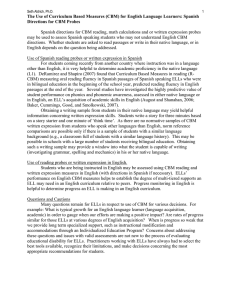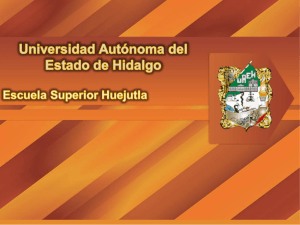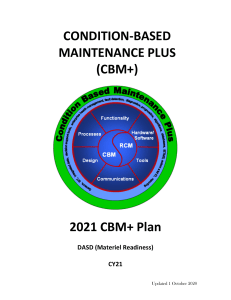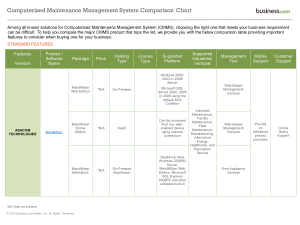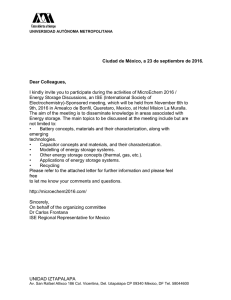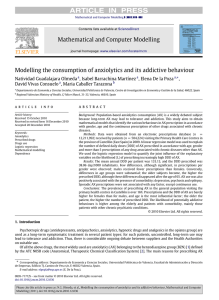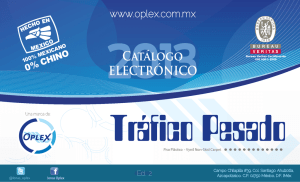E-MAINTENANCE PLATFORM: A BUSINESS PROCESS
Anuncio
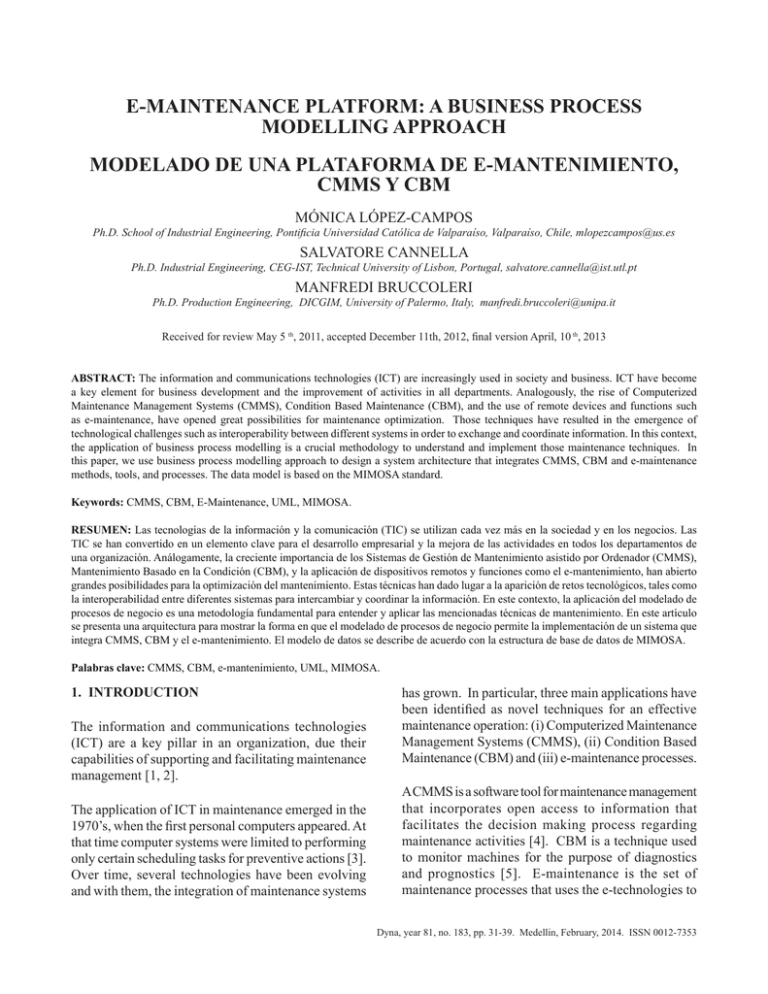
E-MAINTENANCE PLATFORM: A BUSINESS PROCESS MODELLING APPROACH MODELADO DE UNA PLATAFORMA DE E-MANTENIMIENTO, CMMS Y CBM MÓNICA LÓPEZ-CAMPOS Ph.D. School of Industrial Engineering, Pontificia Universidad Católica de Valparaíso, Valparaíso, Chile, mlopezcampos@us.es SALVATORE CANNELLA Ph.D. Industrial Engineering, CEG-IST, Technical University of Lisbon, Portugal, salvatore.cannella@ist.utl.pt MANFREDI BRUCCOLERI Ph.D. Production Engineering, DICGIM, University of Palermo, Italy, manfredi.bruccoleri@unipa.it Received for review May 5 th, 2011, accepted December 11th, 2012, final version April, 10 th, 2013 ABSTRACT: The information and communications technologies (ICT) are increasingly used in society and business. ICT have become a key element for business development and the improvement of activities in all departments. Analogously, the rise of Computerized Maintenance Management Systems (CMMS), Condition Based Maintenance (CBM), and the use of remote devices and functions such as e-maintenance, have opened great possibilities for maintenance optimization. Those techniques have resulted in the emergence of technological challenges such as interoperability between different systems in order to exchange and coordinate information. In this context, the application of business process modelling is a crucial methodology to understand and implement those maintenance techniques. In this paper, we use business process modelling approach to design a system architecture that integrates CMMS, CBM and e-maintenance methods, tools, and processes. The data model is based on the MIMOSA standard. Keywords: CMMS, CBM, E-Maintenance, UML, MIMOSA. RESUMEN: Las tecnologías de la información y la comunicación (TIC) se utilizan cada vez más en la sociedad y en los negocios. Las TIC se han convertido en un elemento clave para el desarrollo empresarial y la mejora de las actividades en todos los departamentos de una organización. Análogamente, la creciente importancia de los Sistemas de Gestión de Mantenimiento asistido por Ordenador (CMMS), Mantenimiento Basado en la Condición (CBM), y la aplicación de dispositivos remotos y funciones como el e-mantenimiento, han abierto grandes posibilidades para la optimización del mantenimiento. Estas técnicas han dado lugar a la aparición de retos tecnológicos, tales como la interoperabilidad entre diferentes sistemas para intercambiar y coordinar la información. En este contexto, la aplicación del modelado de procesos de negocio es una metodología fundamental para entender y aplicar las mencionadas técnicas de mantenimiento. En este artículo se presenta una arquitectura para mostrar la forma en que el modelado de procesos de negocio permite la implementación de un sistema que integra CMMS, CBM y el e-mantenimiento. El modelo de datos se describe de acuerdo con la estructura de base de datos de MIMOSA. Palabras clave: CMMS, CBM, e-mantenimiento, UML, MIMOSA. 1. INTRODUCTION The information and communications technologies (ICT) are a key pillar in an organization, due their capabilities of supporting and facilitating maintenance management [1, 2]. The application of ICT in maintenance emerged in the 1970’s, when the first personal computers appeared. At that time computer systems were limited to performing only certain scheduling tasks for preventive actions [3]. Over time, several technologies have been evolving and with them, the integration of maintenance systems has grown. In particular, three main applications have been identified as novel techniques for an effective maintenance operation: (i) Computerized Maintenance Management Systems (CMMS), (ii) Condition Based Maintenance (CBM) and (iii) e-maintenance processes. A CMMS is a software tool for maintenance management that incorporates open access to information that facilitates the decision making process regarding maintenance activities [4]. CBM is a technique used to monitor machines for the purpose of diagnostics and prognostics [5]. E-maintenance is the set of maintenance processes that uses the e-technologies to Dyna, year 81, no. 183, pp. 31-39. Medellin, February, 2014. ISSN 0012-7353 32 López-Campos et al / Dyna, year 81, no. 183, pp. 31-39, February, 2014. enable proactive decisions in a particular organization (definition partially derived from Levrat et al. [6]). The implementation of these techniques, tools and processes on the shop floor is not a trivial issue. Overall, integrating them into a single software platform is the most challenging concern. Therefore several academics and professionals underline the need for a structured approach to support their actual implementation, use, and integration [7, 8]. In this paper we use business process modelling to develop such a structured approach. Specifically we use Business Process Modelling Notation (BPMN) to represent the flow of activities that are required for an implementation. Secondly, we use the Unified Modelling Language (UML) to represent the principal objects constituting the e-maintenance platform, their relations and static operation structure. Finally, the variety of technologies related to the proposed platform, implies the existence of multiple communication protocols, data connections, configurations, etc. In this respect, we refer to the Maintenance Information Management Open System Alliance (MIMOSA) standard as a useful reference. The paper is organized as follows: Section 2 describes the concept of CMMS, CBM and e-Maintenance. Section 3 contains a literature review and problem statement. Section 4 briefly introduces the business process modelling techniques we use in this paper. Section 5 shows the system architecture for the integration of CMMS, CBM, e-Maintenance in the emaintenance integration platform. Finally, Section 6 provides conclusions and future directions. 2. CMMS, CBM and E-MAINTENANCE The following three subsections detail the most important characteristic of the aforementioned maintenance techniques. 2.1. CMMS The main objective of a CMMS is to provide a tool to analyze maintenance and equipment information in order to optimize the management and support for strategic, tactical and operational decisions. An important requirement for these systems is the compatibility and integration with other systems that contains organizational information. Fumagalli et al. [9] indicate CMMS as a success factor for the organization of maintenance programs. CMMS allows access to information that can be used to prioritize actions and make better decisions in maintenance activities. The CMMS can also provide adequate control of the system. According to Crain [10] incorporating a complete management system in the maintenance function can reduce 10-30% annual budget of the maintenance department. Ros [11] identifies the top five most implemented CMMS systems around the world: SAP Plant Maintenance, Maximo Asset Management, MP2, Ellipse and PMC. 2.2. CBM CBM is defined as the preventive maintenance based on monitoring the operation, the parameters of the element, and the subsequently executed actions [12]. Monitoring is the manual or automatic task of observing the current state and behaviour of a given shop floor element (commonly the thermal and vibratory behaviour) [13]. The final goal of the monitoring task is to adopt a condition-based maintenance approach in order to reduce the probability of failure and prevent irreversible damage to the equipment. CBM allows maximizing the service life of equipment and its components, anticipating failures by monitoring significant parameters. For these reasons, CBM is a key component of proactive maintenance. In recent years, both the reduction of the price of sensors and the increase of information processing capacity have enhanced the development of automatic diagnostic tools. In this context, one of the most widespread applications is the e-CBM, as it is technically feasible, economically viable, and offers many benefits. More specifically, it significantly reduces downtime, saves up to 20% in small production losses, improves quality and reduces stocks of spare parts. [14]. 2.3. E-Maintenance Although the term e-Maintenance has been used since 2000 as a component of eManufacturing, at the present time there is not yet a standardized definition of eMaintenance given by an official institution. We may say that e-Maintenance is “the set of maintenance processes that uses the e-technologies to enable proactive decisions in a particular organization” (definition partially derived from Levrat et al. [6]). Those maintenance processes and methods required to operate them (technologies, procedures, standards, López-Campos et al / Dyna, year 81, no. 183, pp. 31-39, February, 2014. etc) are specific to each organization according to its particular characteristics. This means that, for different organizations, e-Maintenance could involve different spheres of activities. Frequently, these activities include: e-monitoring, e-prognosis, e-diagnosis, e-management, e-service, remote maintenance and, collaborative maintenance. Such activities are supported by means of a variety of hardware and software technologies such as wireless and mobile devices, embedded systems, web based applications, P2P networks, multiagent applications, specific software architectures, communication protocols, among others. 3. LITERATURE REVIEW AND PROBLEM SCOPE 33 “how” these data should be used in order to create an integrated e-maintenance platform. Motivated by these observations, we wish to unambiguously show how to create a fully coordination mechanism combining CMMS, CBM and E-Maintenance. To this aim, we adopt a business process modelling approach and more specifically we use (a) BPMN (a standard for business process modelling) to design the process of integration of the CMMS, CBM and E-Maintenance components; (b) the UML class diagram (a standard for software system design) to design the main software components of the e-maintenance platform and their relationships; (c) MIMOSA for standardizing the interoperability of the platform. In the next section we give a brief overview of the business process modelling languages and standards. We performed a literature review to recognise similar previous attempts at integration of CMMS, CBM and e-maintenance on a single system. The search was specially focused to find projects using modelling languages such as BPMN, UML and/or interoperability standards such as MIMOSA. Specifically, we found 10 studies focused on these issues. A list of these papers is reported in Table 1. In this Table we also reported a summary of the specific problem they deal with and the approach and methodology they use to solve that problem. 4. BUSINESS PROCESS MODELLING Although the referred papers focus on CMMS, CBM, e-maintenance, none of those works clearly propose a structured approach to integrate all of these tools and techniques in a unique platform. This literature review underlines that there is a lack of models that clearly show “which” specific data should be shared among CMMS, CBM and E-Maintenance tools and techniques and From then on, business process modelling has been used in industry to obtain a global vision of processes by means of support, control and monitoring activities [17], to facilitate the comprehension of the business key mechanisms, to be a base for the creation of appropriate information systems [18], to improve the business structure and operations, etc. [19]. Business process modelling, means the use of methods, techniques and software to design, control and analyze operational processes involving humans, organizations, applications, documents and other sources of information [15]. Business process modelling has become an important subject especially since the 1990s, when companies were encouraged to think in terms of “processes” instead of “functions” [16]. Table 1. Literature review Year Author Title Contribution/approach 1995 Deb et al. [20] Multisignal Modeling for Diagnosis, FMECA, and Reliability Developing of a complete solution package for Integrated Diagnostics (ID) It includes some reliability equations. 2001 Finley, and Schneider [21] ICAS: the center of diagnostics and prognostics for the US Navy. The US Navy chose to apply the Integrated Condition Assessment System (ICAS). One of its key requirements to enable CBM is the ability to track machinery performance and diagnose machinery health. System health monitoring and prognostics - A review of current paradigms and practices This paper reviews the philosophies and techniques that focus on improving reliability and reducing unscheduled downtime by monitoring and predicting machine health. It proposes the use of qualitative information, extracted from failure mode and effects analysis (FMEA) or fault tree analysis (FTA) into a quantitative analysis that generates diagnostic recommendations. 2006 Kothamasu et al. [22] 34 López-Campos et al / Dyna, year 81, no. 183, pp. 31-39, February, 2014. Continuation Table 1. Year Author Title Contribution/approach An assembly for MIMOSA OSA-CBM standard is developed on the .NET platform. This paper shows that the integration method for CBM is feasible through a demo program. 2008 Gao et al. [23] Implementation of OSA-CBM standard based on .NET remoting 2008 Nemeth et al. [24] Complex diagnostic methods for lifetime extension of power transformers It shows the main elements to perform complex diagnostic analysis in a transformer system. This paper presents a management system for monitoring and diagnosis. Wessels, and Sautter [8] Reliability analysis required to determine CBM Condition Indicators A reliability-centered analysis is presented that defines the method to correctly select the CBM as a technically and economically viable maintenance solution. This paper proposes a diagram to decide whether or not to implement CBM. It does not integrate CMMS. Li et al. [25] A fast development framework for condition-based maintenance systems In this paper, a framework is proposed to reduce the development complexity of CBM systems, enabling CBM modules independently constructed and dynamically integrated. 2011 Trappey et al. [26] Maintenance chain integration using Petrinet enabled multiagent system modeling and implementation approach This research proposes a collaborative environment integrated by a service center of diagnosis, prognosis, and asset operations. To realize the automation of communication and negotiation, multi-agent systems, Petri-net modeling and UML are applied. 2012 Galar et al. [27] Maintenance decision making based on different types of data fusion This paper proposes a combined data mining-based methodology to collect useful data from a CMMS to be used in CBM processes. Development of an e-operation framework for SoPC-based reconfigurable applications It presents a conceptual framework for e-operations with the capability of e-maintenance, integrating e-diagnostic, among other processes. UML is used as the tool to accomplish the object-oriented analysis and to design the system. 2009 2010 2012 Chang et al. [28] Several benefits deriving from the adoption of business process modelling have been identified in the literature: improvement of the speed of business processes, increase of the clients’ satisfaction, optimization and elimination of unnecessary tasks, and incorporation of clients and partners in the business processes [29]. Process modelling is the subject of interest in many different fields, such as the managerial area [30] and software engineering. This is due to the fact that it does not only describe processes, but in addition it represents a preparatory stage for the improvement of business processes, process reengineering, technological transference and processes standardization [31]. There are several standards for business process modelling. To model the e-maintenance platform proposed in this paper, we use the Unified Modelling Language (UML) and Business Process Modelling Notation (BPMN). Both standards are maintained by the OMG (Object Management Group). During the past years, the most used modelling standards were IDEF (Integration DEFinition), RAD (Role-Activity Diagrams), EXPRESS-G and STEP (Standard for the Exchange of Product model data). However, the use of UML and BPMN standards in modelling maintenance models, processes and software systems is largely increasing. Among other advantages of using BPMN and UML, the easy translation of their models into software code is probably the factor most responsible for their diffusion. [32]. 5. A PROPOSED SYSTEM ARCHITECTURE To obtain the best results of ICT in maintenance, we need to apply the mentioned maintenance techniques in a coordinated manner. Each approach (CMMS, CBM and e-maintenance) is proved to provide benefits to López-Campos et al / Dyna, year 81, no. 183, pp. 31-39, February, 2014. the maintenance management, improving at least the efficiency of the maintenance processes. This architecture show a maintenance system that combines the registers of CMMS with the information provided by sensors, providing a data model to allow the development of a system that combines the features of CMMS and CBM in an e-maintenance platform. In the next subsections we present the main e-maintenance process and the data model for the integration platform. 5.1. E-maintenance process The general operation of the proposed system integration is shown in Figure 1. This Figure shows the activity flow of the CMMS—CBM integration expressed using the BPMN standard. Every maintenance element (CMMS and CBM) is represented by a pool division 35 instead of swimlanes, since CBM and CMMS are two different informatics systems, each one using their own protocols. The tangible output documents are indicated by using the artifact notation. As already mentioned, the third element constituting the e-maintenance integrated platform is the e-maintenance process itself. Indeed, although e-maintenance can be viewed as a technique (or set of techniques), the general idea of our approach is to consider e-maintenance as the whole process of integrating all the maintenance components and elements. In accordance with [33] we consider e-maintenance a philosophy supporting the operation of the entire system and making information exchange possible among remote elements. This is why, there is no pool in the BPMN diagram representing this component, but, instead, it is represented by the flow of activities and Figure 1. BPMN diagram of the integration system the exchange of messages (dotted lines in Figure 1) among CMMS and CBM. 5.2. Data model Figure 2 is a UML class diagram that shows the main software components, their relationships, and the exchanged information. In fact, the UML classes specified for the data model in Figure 2, have been inherited from MIMOSA standard in order to keep the data model compatible with the MIMOSA database structure and to guarantee interoperability. For the sake of clarity, we distinguish class attributes into NEW and MIMOSA attributes. MIMOSA attributes come from simple elaboration and interpretation of the attributes already defined in the MIMOSA specification. On the contrary, NEW attributes are newly defined and have been added only when necessary. Analogously, we omitted from the model those attributes of the MIMOSA specification that are not useful in the scope of this work. Our experience in implementing the MIMOSA standards in real cases, confirmed that interpreting MIMOSA is not an easy subject. For a company, is quite difficult to match its information and knowledge within the MIMOSA specifications. For this 36 López-Campos et al / Dyna, year 81, no. 183, pp. 31-39, February, 2014. reason, the model proposed here is based on our elaboration and interpretation of MIMOSA. A short description now follows in order to help the reader navigate the model. The following classes come directly from the MIMOSA specification: Item, Function, MeasLoc, DataEvent, AlertRegion, ItemRecommendation, ItemRequestForWork and HypotheticalEvent. Two classes have had their names changed with respect to MIMOSA: Alert and EventHistory. Alert represents an alarm. The MIMOSA specification also describes the concept of Alert by a larger number of classes. Here a simplification and synthesis is adopted. EventHistory is a new class introduced to describe the information that is normally stored in a CMMS as records of events happened in the past (like failures, preventive maintenance tasks, etc.); the specification is done by keeping a name conformed to the MIMOSA nomenclature. More in-depth, an item can have more than one MeasLoc (measurement location), i.e. more than one sensor. Hence, the software tool, needed to implement the integration between CMMS-CBM, should be able to automatically identify a MeasLoc, through its IP address and associate it to an Item through a user interface. Figure 2. UML Data model of the integrated system The main idea behind this concept is that common sensors are generally related to an IP. This IP could be the IP of the controller that connects more than one sensor and it is wired to them. There could be also a field-bus to which all the sensors are connected. In these two cases a sub-IP for each sensor can be identified. Moreover, due to new development of smart-sensors [34] it could be envisioned that each sensor is connected to the overall network through its own IP identifier. Following the chain of activities, the MeasLoc is then related with one data event, namely a signal. It is in fact established that a MeasLoc sensor can provide only one DataEvent so the relationship is one to one. If the reader is thinking about sensors providing multiple signals, it is worth remembering that one device may have multiple transducers; this should be considered when utilizing the proposed model . More precisely, in this project the MeasLoc is the soft entity used to identify the transducer in the scope of the integrated system. More than one DataEvent can then be related to an AlertRegion. This defines the boundaries (upper and lower levels) in which a signal is considered normal; out of these bounds something wrong is occurring. One AlertRegion can then provide one or more Alerts. Following the described chain of relations we can state that one Item López-Campos et al / Dyna, year 81, no. 183, pp. 31-39, February, 2014. can generate multiple Alerts and this seems correct. However, we should map one Alert to failure modes to be sure that the system can then properly work, in order to provide information about a specific failure coming from an Alert. The Failure mode is represented according to the interpretation of the MIMOSA definitions by means of an HypotheticalEvent class. This describes all the related events stored in the CMMS data base. One or more failure modes are then associated with a Function and an Item can have one or more functions. To be able to identify one single failure mode by an Alert enough information must be collected. It often happens that one alert is associated with multiple failure modes. So, in order to directly connect one alert to a specific failure mode, one solution is that there are enough monitored variables to assign one alert to each failure mode. In this way, the user is able to connect an Alert with each single failure mode, i.e. with a single instance of HypotheticalEvents class. Besides mapping failure modes to alerts, the user could also be called to connect each failure mode (the HypotheticalEvent in the UML model) with records that represent events that occurred in the real system, related to the failure mode, either as a failure or as a preventive maintenance task planned to avoid the failure (this is the EventHistory in the UML model). When this last relation has been set up, the CMMS database can update in real time the occurrence of an event in the HypotheticalEvent and EventHistory classes. 6. CONCLUSIONS This work proposes a new data model to allow the development of a platform combining the features of the three systems, so fostering the achievement of a synergy among them. More specifically, we show how business process modelling facilitates the process of implementing a system that integrates CMMS, CBM and e-maintenance. A BPMN model was applied to represent the whole process of integration. A UML Class diagram was adopted to show the main elements (and relations) of the e-maintenance integrated platform. MIMOSA was adopted as a reference for designing attributes in the data model. Both researchers and professionals are expected to benefit from the presented research. Researchers can keep exploring different business process modelling 37 techniques to further design e-maintenance process from different perspectives and also to include different maintenance systems and tools. However, the presented research has a strong practical vein. The proposed framework provides practitioners with a methodological approach that concretely support them in developing, implementing and integrating e-maintenance tools. Future developments of this work should consider the validation of the model proposed by means of representative case studies. ACKNOWLEDGEMENTS This research was funded by a grant from the Portuguese Foundation for Science and Technology, grant SFRH/BPD/68576/2010 REFERENCES [1] Khatib, A.R., Zuzhu-Dong, Bin-Qui, Yilu-Liu. Thoughts on future Internet based power system information network architecture, Proceedings of the Power Engineering Society Summer Meeting, Seattle, USA, 2000. [2] Crespo, M.A., Moreu, De L.P., Sanchez, H.A., Ingeniería de Mantenimiento. Técnicas y Métodos de Aplicación a la Fase Operativa de los Equipos, Aenor, España, 2004. [3] Kelly, A., Maintenance Planning and Control, Butterworths, London, 1984. [4] López-Campos, M., Gómez-Fernández, J., HolgadoGranados, M., Crespo-Márquez, A., Aplicación de las tecnologías de la información y la comunicación al mantenimiento, Libro de Ponencias del XII Congreso de Confiabilidad, Madrid, Asociación Española para la Calidad, 2010. [5] Bunks, C., Mccarthy, D. and Al-Ani T., Condition-based maintenance of machines using hidden Markov models. Mechanical Systems and Signal Processing, 14(4), pp. 597-612, 2000. [6] Levrat, E., Iung, B., and Crespo- Marquez, A., E-maintenance: review and conceptual framework, Production Planning & Control , 19(4), pp. 408-429, 2008. [7] Wessels, W. and Sautter, F., Reliability Analysis Required to Determine CBM Condition Indicators, 38 López-Campos et al / Dyna, year 81, no. 183, pp. 31-39, February, 2014. Reliability and Maintainability Symposium, RAMS, 2009. [8] Niu, G., Yang, B.S. and Pecht, M., Development of an optimized condition-based maintenance system by data Fusion and reliability-centered maintenance, Reliability Engineering and System Safety, 95(7), pp.786-796, 2010. [9] Fumagalli, L., Macchi, M. and Rapaccini, M., Computerized Maintenance Management Systems in SMEs: a survey in Italy and some remarks for the implementation of Condition Based Maintenance, 13th IFAC Symposium of Information Control Problems in Manufacturing, Moscow, 2009. [10] Crain, M., The Role of CMMS, Industrial Technologies Northern Digital, Inc, 2003. [11] Ros Moreno, A., Capítulo 33: Mantenimiento industrial. Software informático (1/2). Disponible en: http:// www.mailxmail.com/curso-mantenimiento-industrial-2-3/ mantenimiento-industrial-software-informatico-1-2 [consultado 17 de octubre 2010]. [12] UNE-EN 13306 Terminología de Mantenimiento. AENOR, Madrid, 2002. [13] Aguiar, M., Gómez, J. y Torres, P., Modelamiento térmico y vibratorio de una cápsula para sensores de fibra óptica adaptables a mediciones de sistemas eléctricos de potencia, Dyna, 76(157), pp. 243-250, 2009. [14] Djurdjanovic, D., Lee, J. and Ni, J., Watchdog Agent—an infotronics-based prognostics approach for product performance degradation assessment and prediction, Advanced Engineering Informatics 17, pp.109-125, 2003. [15] Van Der Aalst, W., Don´t go with the flow: Web services composition standards exposed. IEEE Intelligent Systems, 18(1), 2003. [16] López Campos, M., Crespo Márquez, A., Modelling a maintenance management framework based on PAS 55 standard. Quality and Reliability Engineering Int, 27(6), pp. 805-820, 2011. [17] Russel, N., Vanderalst, W., Hofstede, A. and Wohed, P., On the suitability of UML Activity Diagrams for Business Proces Modelling. Proceedings of the Third Asia-PAcific Conference on Conceptual Modelling (APCCM), vol. 53 of Conferences in Research and Practice Information Technologies, pp.195–104, 2006. [18] Quiescenti, M., Bruccoleri, M., La Commare, U., Noto La Diega, S. and Perrone, G., Business process-oriented design of Enterprise Resource Planning (ERP) systems for small and medium enterprises. International Journal of Production Research, vol 44, no. 18-19, pp. 3797-3811, 2006. [19] Beck, K., Joseph, J. and Goldszmidt, G., Learn Business Process Modeling Basics for the Analyst. Disponible en: www-128ibm.com/developersworks/library/wsbpm4analyst [consultado 17 de octubre 2010]. [20] Deb, S., Ghoshal, S., Mathur, R., Shrestha, Pattipati R., Multisignal modeling for diagnosis, FMECA and reliability, Proceedings of the IEEE Int Conference on Systems, Man and Cybernetics 3, pp. 3026-3031, 1998. [21] Finley, B., Schneider, E., ICAS: the center of diagnostics and prognostics for the United States navy. Proceedings of the SPIE – Int. Soc. Opt. Eng. 4389, pp. 186-193, 2001. [22] Kothamasu, R., Huang, S. and Derduin, W., System health monitoring and prognostics – a review of current paradigms and practices, Int J Adv Manuf Techol 28, pp.1012-1024, 2006. [23] Gao, Z., Li, X., Pan, Q. and Zhang, L., Implementation of OSA-CBM standard based on .NET remoting, Chinese Journal of Scientific Instrument 29 (SUPPL. 2), pp. 123126, 2008. [24] Németh, B., Benyó, T., Jáger, A., Csépes, G. and Woynárovich, G., Complex diagnostic methods for lifetime extension of power transformers. Conference Record of IEEE Int Symposium on Electrical Insulation, art. no. 4570296, pp. 132-135, 2008. [25] Li, L., Qian, Y., Du, K. and Yang, Y., A fast development framework for condition-based maintenance systems. ICMEE 2010 - 2010 2nd Int Conference on Mechanical and Electronics Engineering, Proceedings 2, art. no. 5558484, pp. V270-V274, 2010. [26] Trappey, A.J.C., Hsiao, D.W. and Ma, L., Maintenance chain integration using Petri-net enabled multiagent system modeling and implementation approach, IEEE Transactions on Systems, Man and Cybernetics Part C: Applications and Reviews, vol. 41 (3), pp. 306-315, 2011. [27] Galar, D., Gustafson, A., Tormos, B. and Berges, L., Maintenance decision making based on different types of data fusion, Eksploatacja i Niezawodnosc, vol. 14 (2), pp. 135-144, 2012. López-Campos et al / Dyna, year 81, no. 183, pp. 31-39, February, 2014. [28] Chang, Y., Chen, Y., Hung, M., Chang, A.Y., Development of an e-operation framework for SoPC-based reconfigurable applications, Int Journal of Innovative Computing, Information and Control, vol. 8.(5 B), pp. 3639-3660, 2012. [29] Pérez, J. et al. Model Driven Engineering Aplicado a Business Process Management. Informe Técnico UCLMTSI-002, 2007. [30] Ferreira, L., Del Conte, D. y Poppi, S., Aplicación de la UML como herramienta de auxilio en la gestión empresarial, Revista Avances en Sistemas e Informática, 7 (1), 2010. [31] Succi, G. Predonzani, P. et al. Business Process Modeling with Objects, Costs and Human Resources. 39 Systems Modeling for Business Process Improvement. Artech House, London, pp. 47-60, 2000. [32] Muñetón, A. and Zapata, C., Definition of a semantic platform for automated code generation based on UML class diagrams and DSL semantic annotations, Dyna 79(172), pp. 94-100, 2012. [33] Iung, B., Levrat, E., Crespo Márquez, A. and Erbe, H., Conceptual Framework for e-Maintenance: Illustration by e-Maintenance technologies and platforms. Annual Reviews in Control, 33, pp. 220-229, 2009. [34] Garetti, M., Macchi, M., Terzi, S. and Fumagalli, L., Investigating the organizational business models of maintenance when adopting self diagnosing and self healing ICT systems in multi site contexts. Paper presented to the IFAC-CEA 07, Monterrey, Mexico, 2007.
